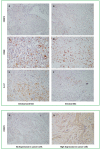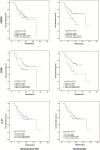Tumor-infiltrating lymphocytes predict prognosis of breast cancer patients treated with anti-Her-2 therapy
- PMID: 28029650
- PMCID: PMC5354903
- DOI: 10.18632/oncotarget.14124
Tumor-infiltrating lymphocytes predict prognosis of breast cancer patients treated with anti-Her-2 therapy
Abstract
Purpose: Infiltration of tumor associated lymphocytes and count of its different phenotypes are potentially new independent predictor of prognosis in breast cancer. However, research related to it is less reported in breast cancer patients treated with anti-Her-2 therapy. Thus, we evaluated the relationship between survival and tumor infiltrating lymphocytes including its different phenotypes in tumors of such patients.
Methods: Between 1999 and 2010, 98 patients diagnosed with primary breast cancer and treated with anti-Her-2 therapy at Sun-Yat-Sen University Cancer Center were included in the study. Biopsy specimens were collected post-operation but before chemotherapy. Tumor infiltrating lymphocytes as well as its FOXP3+, CD68+, IL-17+ phenotypes in both intratumoral and stromal sites and expression of FOXP3 in cancer cells were assessed.
Results: Median follow-up time of 98 patients was 83.3 months (range 7.4-201 months). It suggested that patients with high stromal infiltration of TILs, lower count of FOXP3+ Tregs and CD68+ Mφ in stromal site, and high expression of FOXP3 in cancer cells had longer survival of OS. In multivariate Cox regression analysis, high count of intratumoral CD68+ Mφ [HR: 2.70 (1.00-7.31); p=0.050] and high expression of FOXP3 in cancer cells [HR: 0.29 (0.09-0.91); p=0.034] were independent prognostic factors for overall survival.
Conclusions: Tumor infiltrating lymphocytes as well as its FOXP3+, CD68+ phenotypes in stromal site, and expression of FOXP3 in cancer cells were significantly associated with OS, suggesting that they can be used as important pathological factor predicting prognosis of breast cancer patients treated with anti-Her-2 therapy.
Keywords: TILs; anti-Her-2 therapy; breast cancer; prognosis.
Conflict of interest statement
The authors declared that they have no competing interests.
Figures




Similar articles
-
Association of intra-tumoral infiltrating macrophages and regulatory T cells is an independent prognostic factor in gastric cancer after radical resection.Ann Surg Oncol. 2011 Sep;18(9):2585-93. doi: 10.1245/s10434-011-1609-3. Epub 2011 Feb 23. Ann Surg Oncol. 2011. PMID: 21347781
-
Optimal threshold for stromal tumor-infiltrating lymphocytes: its predictive and prognostic value in HER2-positive breast cancer treated with trastuzumab-based neoadjuvant chemotherapy.Breast Cancer Res Treat. 2015 Nov;154(2):239-49. doi: 10.1007/s10549-015-3617-7. Epub 2015 Oct 26. Breast Cancer Res Treat. 2015. PMID: 26498019
-
Prognostic value of tumor infiltrating lymphocyte subsets in breast cancer depends on hormone receptor status.Breast Cancer Res Treat. 2017 Feb;161(3):409-420. doi: 10.1007/s10549-016-4072-9. Epub 2016 Dec 2. Breast Cancer Res Treat. 2017. PMID: 27913931
-
Clinical significance of tumor-infiltrating lymphocytes in breast cancer.J Immunother Cancer. 2016 Oct 18;4:59. doi: 10.1186/s40425-016-0165-6. eCollection 2016. J Immunother Cancer. 2016. PMID: 27777769 Free PMC article. Review.
-
High tumor-infiltrating FoxP3+ T cells predict poor survival in estrogen receptor-positive breast cancer: A meta-analysis.Eur J Surg Oncol. 2017 Jul;43(7):1258-1264. doi: 10.1016/j.ejso.2017.01.011. Epub 2017 Jan 30. Eur J Surg Oncol. 2017. PMID: 28214052 Review.
Cited by
-
Overexpression of TPX2 predicts poor clinical outcome and is associated with immune infiltration in hepatic cell cancer.Medicine (Baltimore). 2020 Dec 4;99(49):e23554. doi: 10.1097/MD.0000000000023554. Medicine (Baltimore). 2020. PMID: 33285774 Free PMC article.
-
Development of Cancer Immunotherapies.Cancer Treat Res. 2022;183:1-48. doi: 10.1007/978-3-030-96376-7_1. Cancer Treat Res. 2022. PMID: 35551655
-
Conceptual Development of Immunotherapeutic Approaches to Gastrointestinal Cancer.Int J Mol Sci. 2019 Sep 18;20(18):4624. doi: 10.3390/ijms20184624. Int J Mol Sci. 2019. PMID: 31540435 Free PMC article. Review.
-
Cytokine Modulation in Breast Cancer Patients Undergoing Radiotherapy: A Revision of the Most Recent Studies.Int J Mol Sci. 2019 Jan 17;20(2):382. doi: 10.3390/ijms20020382. Int J Mol Sci. 2019. PMID: 30658426 Free PMC article. Review.
-
Blood and Cancer: Cancer Stem Cells as Origin of Hematopoietic Cells in Solid Tumor Microenvironments.Cells. 2020 May 22;9(5):1293. doi: 10.3390/cells9051293. Cells. 2020. PMID: 32455995 Free PMC article. Review.
References
-
- Slamon DJ, Clark GM, Wong SG, Levin WJ, Ullrich A, McGuire WL. Human breast cancer: correlation of relapse and survival with amplification of the HER-2/neu oncogene. Science. 1987;235:177–82. - PubMed
-
- Cobleigh MA, Vogel CL, Tripathy D, Robert NJ, Scholl S, Fehrenbacher L, Wolter JM, Paton V, Shak S, Lieberman G, Slamon DJ. Multinational study of the efficacy and safety of humanized anti-HER2 monoclonal antibody in women who have HER2-overexpressing metastatic breast cancer that has progressed after chemotherapy for metastatic disease. J Clin Oncol. 1999;17:2639–48. - PubMed
-
- Disis M L SJ, Wallace D, et al. Cellular immune parameters associated with improved long-term survival in advanced stage breast cancer patients after active immunization with a HER2-specific vaccine. ASCO. 2008:3015.
MeSH terms
Substances
LinkOut - more resources
Full Text Sources
Other Literature Sources
Medical
Molecular Biology Databases
Research Materials
Miscellaneous

